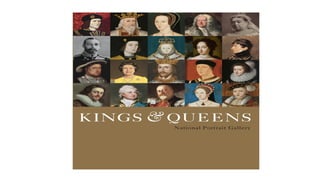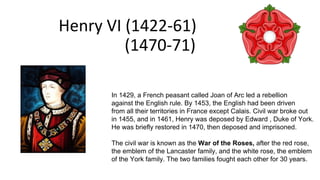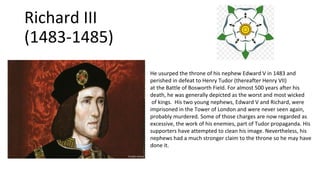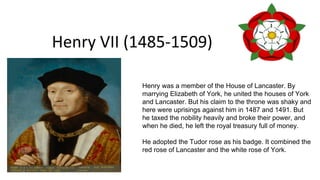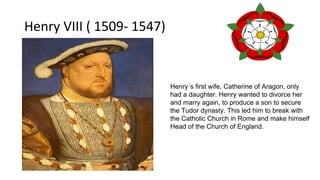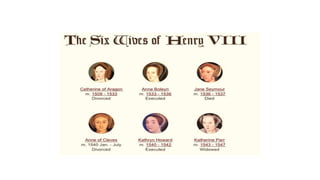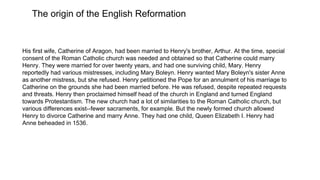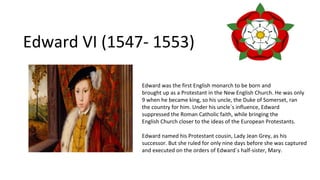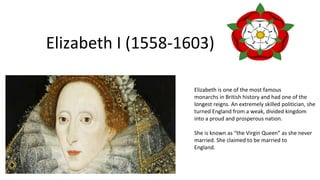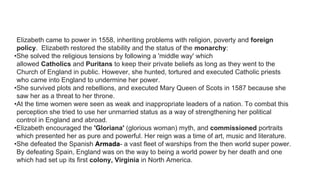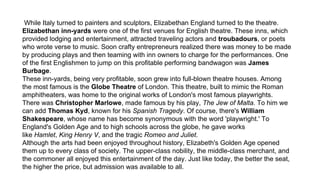tudors ESTE POWER POINT ES PARA ESTUDIA
- 2. Henry VI (1422-61) (1470-71) In 1429, a French peasant called Joan of Arc led a rebellion against the English rule. By 1453, the English had been driven from all their territories in France except Calais. Civil war broke out in 1455, and in 1461, Henry was deposed by Edward , Duke of York. He was briefly restored in 1470, then deposed and imprisoned. The civil war is known as the War of the Roses, after the red rose, the emblem of the Lancaster family, and the white rose, the emblem of the York family. The two families fought each other for 30 years.
- 3. Edward IV (1461-70) (1471-83) At the age of 18, Edward, Duke of York deposed and imprisoned his cousin, Henry VI, and was crowned king as Edward IV. Henry was briefly restored in 1470, but was deposed again the following year. Edward brought England peace and prosperity after years of civil war.
- 4. Richard III (1483-1485) He usurped the throne of his nephew Edward V in 1483 and perished in defeat to Henry Tudor (thereafter Henry VII) at the Battle of Bosworth Field. For almost 500 years after his death, he was generally depicted as the worst and most wicked of kings. His two young nephews, Edward V and Richard, were imprisoned in the Tower of London and were never seen again, probably murdered. Some of those charges are now regarded as excessive, the work of his enemies, part of Tudor propaganda. His supporters have attempted to clean his image. Nevertheless, his nephews had a much stronger claim to the throne so he may have done it.
- 5. Henry VII (1485-1509) Henry was a member of the House of Lancaster. By marrying Elizabeth of York, he united the houses of York and Lancaster. But his claim to the throne was shaky and here were uprisings against him in 1487 and 1491. But he taxed the nobility heavily and broke their power, and when he died, he left the royal treasury full of money. He adopted the Tudor rose as his badge. It combined the red rose of Lancaster and the white rose of York.
- 6. Henry VIII ( 1509- 1547) Henry┬┤s first wife, Catherine of Aragon, only had a daughter. Henry wanted to divorce her and marry again, to produce a son to secure the Tudor dynasty. This led him to break with the Catholic Church in Rome and make himself Head of the Church of England.
- 8. His first wife, Catherine of Aragon, had been married to Henry's brother, Arthur. At the time, special consent of the Roman Catholic church was needed and obtained so that Catherine could marry Henry. They were married for over twenty years, and had one surviving child, Mary. Henry reportedly had various mistresses, including Mary Boleyn. Henry wanted Mary Boleyn's sister Anne as another mistress, but she refused. Henry petitioned the Pope for an annulment of his marriage to Catherine on the grounds she had been married before. He was refused, despite repeated requests and threats. Henry then proclaimed himself head of the church in England and turned England towards Protestantism. The new church had a lot of similarities to the Roman Catholic church, but various differences exist--fewer sacraments, for example. But the newly formed church allowed Henry to divorce Catherine and marry Anne. They had one child, Queen Elizabeth I. Henry had Anne beheaded in 1536. The origin of the English Reformation
- 9. Consequences of Henry VIII's reign Henry's reign was a time of tyranny and executions, but there were changes which can be seen as the start of modern England: ŌĆóThe dissolution of the monasteries caused suffering for ordinary people as these had been places for the poor to seek relief. In the short term this caused the rebellion known as the Pilgrimage of Grace (1536). ŌĆóIn the long term it led to the Poor Laws which, 400 years later, led unintentionally to the welfare state ŌĆō the modern system that helps citizens financially. ŌĆóHenry VIII used Parliament to pass his laws, which helped to establish the authority of Parliament. ŌĆóThe power of the gentry rose, and the power of the nobles declined. ŌĆóAlthough Henry VIII remained a Catholic, the break with Rome eventually turned England into ŌĆó a Protestant country. ŌĆóHenry built more warships. Some historians regard this as the start of the Royal Navy. ŌĆóThe Act in Restraint of Appeals turned out to be the most important act in the history of England. It said that this realm of England is an Empire ie that England was a sovereign state, subject only to its own government. It was therefore the legal beginning of the English nation. ŌĆóEngland remained completely legally independent until 1953, when the government signed up to the European Court of Human Rights.
- 10. Edward VI (1547- 1553) Edward was the first English monarch to be born and brought up as a Protestant in the New English Church. He was only 9 when he became king, so his uncle, the Duke of Somerset, ran the country for him. Under his uncle┬┤s influence, Edward suppressed the Roman Catholic faith, while bringing the English Church closer to the ideas of the European Protestants. Edward named his Protestant cousin, Lady Jean Grey, as his successor. But she ruled for only nine days before she was captured and executed on the orders of Edward┬┤s half-sister, Mary.
- 11. Mary I (1553-1558) Mary was supported by the majority of English people during The first year of her reign. But after she tried to re-impose the Catholic faith and then married her Catholic cousin, Prince Phillip of Spain, she became very unpopular. She had a nickname: ŌĆ£Bloody MaryŌĆØ on account of her persecution of Protestants. They were hounded out of important jobs and 300 were burned at the stake of their religious beliefs.
- 12. Elizabeth I (1558-1603) Elizabeth is one of the most famous monarchs in British history and had one of the longest reigns. An extremely skilled politician, she turned England from a weak, divided kingdom into a proud and prosperous nation. She is known as ŌĆ£the Virgin QueenŌĆØ as she never married. She claimed to be married to England.
- 13. Elizabeth came to power in 1558, inheriting problems with religion, poverty and foreign policy. Elizabeth restored the stability and the status of the monarchy: ŌĆóShe solved the religious tensions by following a 'middle way' which allowed Catholics and Puritans to keep their private beliefs as long as they went to the Church of England in public. However, she hunted, tortured and executed Catholic priests who came into England to undermine her power. ŌĆóShe survived plots and rebellions, and executed Mary Queen of Scots in 1587 because she saw her as a threat to her throne. ŌĆóAt the time women were seen as weak and inappropriate leaders of a nation. To combat this perception she tried to use her unmarried status as a way of strengthening her political control in England and abroad. ŌĆóElizabeth encouraged the 'Gloriana' (glorious woman) myth, and commissioned portraits which presented her as pure and powerful. Her reign was a time of art, music and literature. ŌĆóShe defeated the Spanish Armada- a vast fleet of warships from the then world super power. By defeating Spain, England was on the way to being a world power by her death and one which had set up its first colony, Virginia in North America.
- 14. ŌĆóHer reign was a time of art, music and literature with the talents of William Shakespeare flourishing at this time. It is often known as 'the Golden Age of English history'. ŌĆóHer long reign created stability. When she died, James VI of Scotland, the son of her cousin Mary Queen of Scots, inherited the throne peacefully. ŌĆóBy the end of her reign, the Church of England was safe, and there was no chance of a War of Religion. ŌĆóBy the end of her reign, England was a world power. Pope Sixtus V could not understand it: "She is only a woman, only mistress of half an island, and yet she makes herself feared by Spain, by France, by all.ŌĆ£ Pope Sixtus V
- 15. While Italy turned to painters and sculptors, Elizabethan England turned to the theatre. Elizabethan inn-yards were one of the first venues for English theatre. These inns, which provided lodging and entertainment, attracted traveling actors and troubadours, or poets who wrote verse to music. Soon crafty entrepreneurs realized there was money to be made by producing plays and then teaming with inn owners to charge for the performances. One of the first Englishmen to jump on this profitable performing bandwagon was James Burbage. These inn-yards, being very profitable, soon grew into full-blown theatre houses. Among the most famous is the Globe Theatre of London. This theatre, built to mimic the Roman amphitheaters, was home to the original works of London's most famous playwrights. There was Christopher Marlowe, made famous by his play, The Jew of Malta. To him we can add Thomas Kyd, known for his Spanish Tragedy. Of course, there's William Shakespeare, whose name has become synonymous with the word 'playwright.' To England's Golden Age and to high schools across the globe, he gave works like Hamlet, King Henry V, and the tragic Romeo and Juliet. Although the arts had been enjoyed throughout history, Elizabeth's Golden Age opened them up to every class of society. The upper-class nobility, the middle-class merchant, and the commoner all enjoyed this entertainment of the day. Just like today, the better the seat, the higher the price, but admission was available to all.
